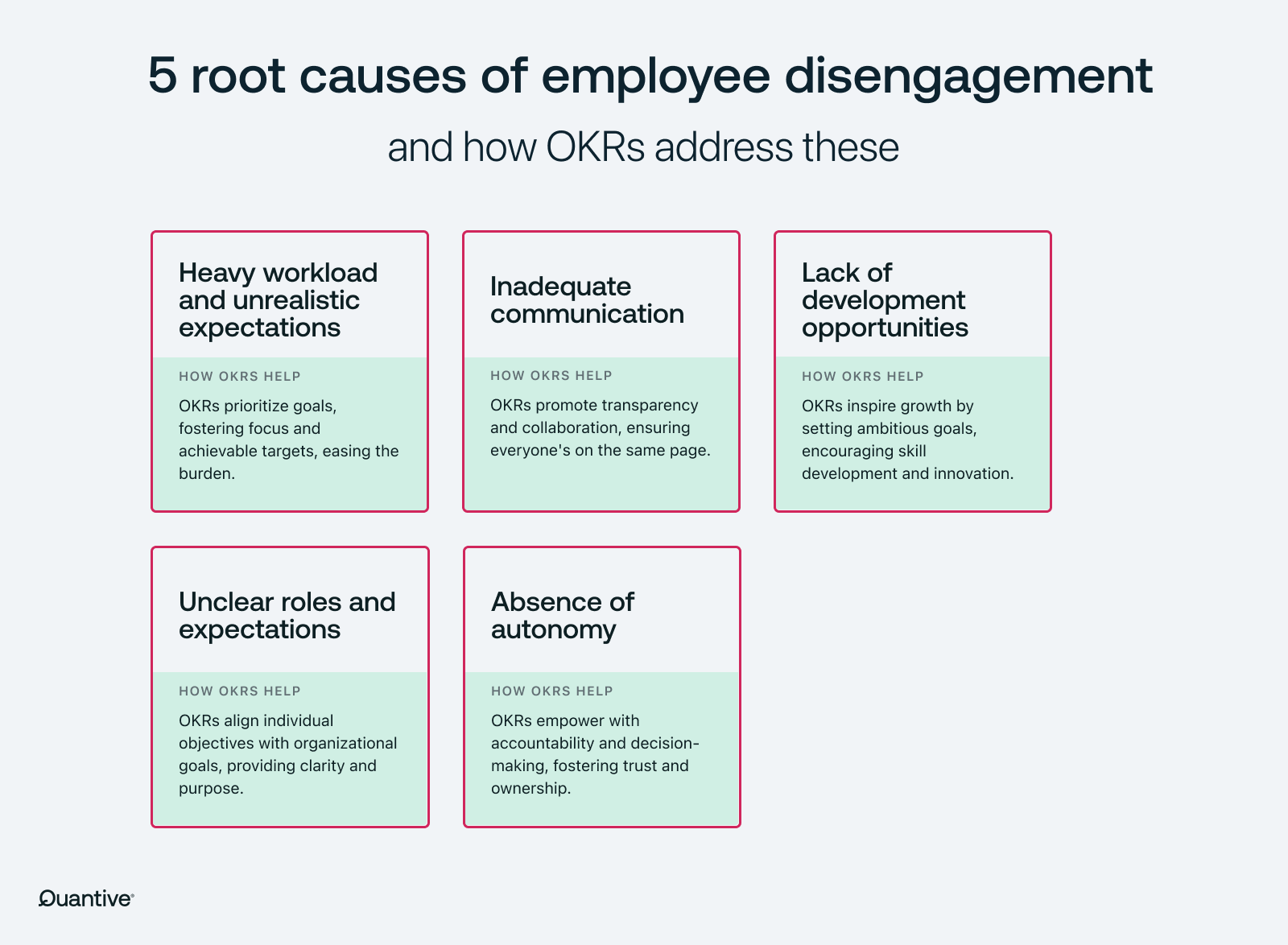Quantive is now part of WorkBoard. Get to know WorkBoard:
Employee engagement has always been crucial to business delivery — your business performance reflects how well employees connect the work they do to your company vision.
When employees are engaged, your profits, productivity, morale, and retention rates shoot up. When they’re not, absenteeism, turnover, and quality defects skyrocket. When push comes to shove, and market circumstances turn dire, disengaged employees are quick to exit — easily spurring events like the ‘Great Resignation.’
The question then remains: How do you keep employees engaged?
For sustained employee engagement, your business needs an actionable, well-rounded, and strategic approach to keep employees motivated and inspired — one fully embedded in your business’s fabric, culture, and day-to-day operations.
This article proposes objectives and key results (OKRs) as a framework for driving employee engagement, covering how OKRs enhance employee engagement by helping you overcome the root causes of employee disengagement.
What are OKRs?
The OKR framework empowers your business to create, track, and achieve ambitious goals in a focused, collaborative, and measurable way. It does so using two components: objectives and key results.
- Objectives are concise, qualitative descriptions of what you’re looking to achieve
- Key results are quantitative measures that track progress toward individual objectives
As an OKR best practice, we recommend creating 3-5 key results per objective to ensure prioritization, clarity, and accountability toward each OKR.
“Healthy culture and structured goal setting are interdependent.”
—John E. Doerr, Measure What Matters
How OKRs tackle the 5 root causes of employee disengagement
Now, you may wonder, “How can a mere goal-setting framework drive employee engagement?”
Simply put, using OKRs for employee engagement can help you counteract the key triggers of disengagement. These triggers include:
- Heavy workload and unrealistic expectations
- Inadequate communication
- Lack of development opportunities
- Unclear roles and expectations
- Absence of workplace autonomy
Let’s take an in-depth look at each of these and see how OKRs can help you overcome them.
Heavy workload and unrealistic expectations
When employees face a significant gap between the tasks they're expected to complete and the available resources, their sense of achievement and contentment can be negatively impacted. This mismatch between high demands and limited resources can lead to feelings of inadequacy and frustration, typically snowballing into poor team dynamics and performance.
Additionally, pushing unattainable goals and unrealistic expectations can erode employees’ self-confidence. If employees perceive their efforts to be ineffective no matter how hard they try, their motivation for tasks and projects also diminishes.
As such, employees burdened with excessive workloads and unattainably high standards may end up exhausted, discouraged, and unenthusiastic at work — ultimately driving disengagement.
OKR solution: Focus and prioritization
OKRs address the problem of excessive workload and unrealistic expectations by emphasizing focus and prioritization on challenging, attainable, and meaningful goals. By offering a structured method to define team, departmental, and functional goals in alignment with vital organizational objectives, OKRs ensure all levels of your business generate value toward crucial goals instead of pursuing scattered, insignificant goals that neither contribute to organizational impact nor alleviate overwhelm.
Beyond this, OKRs enhance employee engagement by promoting a suitable challenge. The framework stresses the significance of setting ambitious goals while underscoring the need for attainability. As a result, OKRs can stimulate lateral thinking and innovation among employees, driving curiosity and engagement instead of demotivation.
Poor communication of strategic goals
Effective communication is vital for building a united and engaged workforce. If organizational goals, decisions, and changes aren’t communicated well, and recognition or feedback is missing, employees lose sight of the bigger picture. They become disconnected from wider organizational objectives. This uncertainty about the company’s direction reduces employees’ motivation and engagement — if they aren’t aware of what they’re striving for, how can they find purpose in their efforts?
OKR solution: Transparency and collaboration
You can use OKRs for employee engagement, as these improve business communications in two ways.
Firstly, creating shared OKRs involves joint goal-setting sessions that engage executives, managers, team leaders, and individual employees across functions. This approach ensures active involvement of every organizational tier, fostering a collective effort toward overarching company goals.
Secondly, the OKR framework emphasizes the value of regular weekly or bi-weekly check-ins to evaluate OKR progress, share insights, tackle challenges, and address necessary changes. These sessions maintain a shared understanding of where the company is, where it’s headed, and what actions are required.
Combined, these aspects strengthen your internal communications and encourage contributions at all levels of the organization, enabling you to benefit from using OKRs for employee engagement.
Lack of development opportunities
If your employees sense a lack of growth and learning opportunities within your organization, they’re unlikely to put their best foot forward. Believing that their potential won’t be acknowledged, skills won’t evolve, and career growth is restricted can diminish employees’ motivation, leading to disengagement from their tasks, job, and broader organizational objectives.
OKR solution: Ambitious goals and growth
As mentioned, OKRs inspire employees to chase ambitious goals that demand experimentation, innovation, and skill development. Going beyond ordinary tasks, OKRs raise the standards for typical milestones, encouraging personal and professional growth.
Additionally, the feedback loops built into OKRs offer an avenue for employees to receive consistent guidance, encouraging them to improve and stretch their capabilities continuously. As such, OKRs enhance employee engagement by motivating employees to expand their skill sets, attain daring goals, and push past their current capabilities.
“For companies seeking to live long and prosper, stretching to new heights is compulsory.”
— John E. Doerr, Measure What Matters
Ambitious role-goal link
Employees who don't understand how they contribute to organizational objectives may feel unsure about their role's significance and impact. This ambiguity can impact their ability to find meaning, purpose, and value in their tasks, creating isolation and detachment over their day-to-day tasks. Consequently, they lack the satisfaction of recognizing their contributions to advancing the company’s broader goals, leading to disconnect, disengagement, and an overall lack of organizational alignment.
OKR solution: Alignment and purpose
The OKR framework carefully weaves organizational, team, and individual objectives, where overarching business goals cascade to all business levels. This top-to-bottom goal alignment ensures that employees understand their role in advancing the organization’s strategic direction. This not only enhances focus but also nurtures purpose and engagement.
“Connect the dots between individual roles and the goals of the organization. When people see that connection, they get a lot of energy out of work. They feel the importance, dignity, and meaning in their job.”
— Ken Blanchard
Read more on using OKRs for business alignment

Absence of autonomy
A lack of employee autonomy, typically fueled by distrust and micromanagement, can result in disengagement. This distrust undermines their decision-making skills and can discourage them from sharing their ideas, causing their ownership of their work to fade. This can gradually chip away at their enthusiasm, leading to disengagement from their tasks and organization.
OKR solution: Accountability and empowerment
OKRs empower employees by granting them autonomy and responsibility in several ways. Firstly, they allow employees to take ownership of their work by creating goals that align with the company's overarching strategy. Secondly, OKRs encourage regular check-ins and feedback mechanisms, ensuring employees stay aligned and motivated toward achieving their objectives. Lastly, the framework enables employees to see their contributions, showcasing how their efforts contribute to company objectives in a quantifiable manner.
“The key element of engagement is trust; building trust requires companies to provide workers with as much autonomy and flexibility as possible.”
– Matt Charney

Creating OKRs for employee engagement
Beyond using OKRs as a framework for engaging employees across your organization, you can also create employee engagement OKRs to measure different employee engagement metrics and ensure they're progressing as expected.
To inspire your employee engagement OKRs, here are some employee engagement OKR examples:
Employee engagement OKR example 1: Employee growth and development
Objective: Be the gold standard for employee development
Key result 1: See a 20% rise in employees taking on roles or projects requiring newly acquired skills.
Key result 2: Witness a 25% improvement in average post-training assessment scores
Key result 3: Achieve a 10% increase in internal promotions
Employee engagement OKR example 2: Employee appreciation
Objective: Make every employee feel valued
Key result 1: Record a 15% increase in employee Net Promoter Score (eNPS)
Key result 2: Witness a 10% reduction in turnover rates of top-performing employees
Key result 3: Observe a 15% uplift in overall team morale scores
Employee engagement OKR example 3: Cross-functional collaboration
Objective: Break silos, build bridges
Key result 1: Achieve a 20% increase in project outcomes involving cross-departmental collaboration
Key result 2: Record a 15% reduction in issue resolution time for projects involving multiple departments
Key result 3: Achieve a 25% increase in positive inter-departmental feedback on collaboration in annual employee surveys

Need more ideas? Here are 15+ HR OKR examples to help you drive employee engagement

Take employee engagement to the next level with OKR software
OKR software can strengthen the employee engagement capabilities offered by OKRs, taking the manual hassle out of setting, updating, and managing your OKRs on static tools such as spreadsheets while making it easier for your employees to adopt the OKR framework.
OKR software enables you to streamline the process of setting joint objectives, defining measurable key results, tracking progress, and fostering team cooperation. The right OKR software for your business provides:
- A centralized platform for setting, tracking, and managing your cascading OKRs, simplifying OKR ownership and alignment
- Real-time data insights for continuous feedback generation, visibility, and driving meaningful work across your organization
- Collaborative features such as whiteboards and team progress tracking help your teams work together on setting OKRs and share progress on the work they’re doing
- Data visualization options for employees to monitor progress easily, see how their work fits into the bigger picture, and identify areas for improvement throughout the OKR cycle
- Configurable workflows that allow you to embed OKRs into existing processes, meetings, training, and everyday tools
- Feedback mechanisms and confidence level features create a continuous feedback loop, facilitating ongoing communication and alignment between managers, employees, and the broader organization
See how you can improve employee engagement with OKR software's powerful features.
Using OKRs and OKR software for employee engagement
Central to your organization’s success, employee engagement influences everything from productivity to profitability. Recognizing this, you need to tackle disengagement proactively — and that’s where the OKR framework steps in.
OKRs enhance the employee experience by facilitating ambitious goal setting, individual empowerment, goal alignment, teamwork, and focusing on what matters. Robust OKR software can take this impact even further. The right OKR software for your business offers collaboration features, data visualization capabilities, and dynamic feedback mechanisms, making it a must-have tool for integrating OKRs and cultivating a motivated and engaged workforce within your business.
Quantive empowers modern organizations to turn their ambitions into reality through strategic agility. It's where strategy, teams, and data come together to drive effective decision-making, streamline execution, and maximize performance.
As your company navigates today’s competitive landscape, you need an Always-On Strategy to continuously bridge the gap between current and desired business outcomes. Quantive brings together the technology, expertise, and passion to transform your strategy and playbooks from a static formulation to a feedback-driven engine for growth.
Whether you’re a fast-growing scale-up, a mid-market business looking to conquer, or a large enterprise looking for innovation, Quantive keeps you ahead – every step of the way. For more information, visit www.quantive.com.





